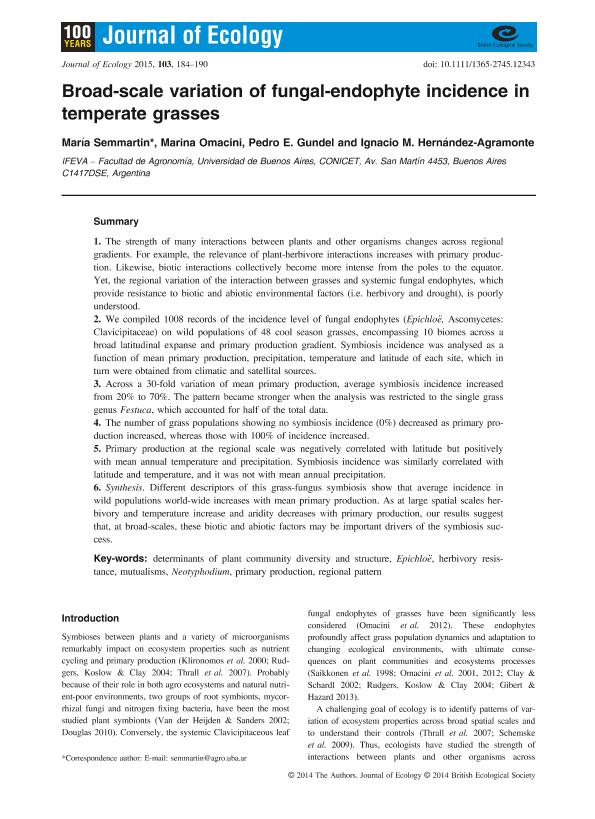Artículo
Broad-scale variation of fungal-endophyte incidence in temperate grasses
Fecha de publicación:
03/2015
Editorial:
Wiley
Revista:
Journal of Ecology
ISSN:
0022-0477
Idioma:
Inglés
Tipo de recurso:
Artículo publicado
Clasificación temática:
Resumen
1.The strength of many interactions between plants and other organisms changes across regional gradients. For example, the relevance of plant-herbivore interactions increases with primary production. Likewise, biotic interactions collectively become more intense from the poles to the equator. Yet, the regional variation of the interaction between grasses and systemic fungal endophytes, which provide resistance to biotic and abiotic environmental factors (i.e. herbivory and drought), is poorly understood.<br />2. We compiled 1008 records of the incidence level of fungal endophytes (Epichlo?e, Ascomycetes: Clavicipitaceae) on wild populations of 48 cool season grasses, encompassing 10 biomes across a broad latitudinal expanse and primary production gradient. Symbiosis incidence was analysed as a function of mean primary production, precipitation, temperature and latitude of each site, which in turn were obtained from climatic and satellital sources.<br />3. Across a 30-fold variation of mean primary production, average symbiosis incidence increased from 20% to 70%. The pattern became stronger when the analysis was restricted to the single grass genus Festuca, which accounted for half of the total data.<br />4. The number of grass populations showing no symbiosis incidence (0%) decreased as primary production increased, whereas those with 100% of incidence increased.<br />5. Primary production at the regional scale was negatively correlated with latitude but positively with mean annual temperature and precipitation. Symbiosis incidence was similarly correlated with latitude and temperature, and it was not with mean annual precipitation. <br />6. Synthesis. Different descriptors of this grass-fungus symbiosis show that average incidence in wild populations world-wide increases with mean primary production. As at large spatial scales herbivory and temperature increase and aridity decreases with primary production, our results suggest that, at broad-scales, these biotic and abiotic factors may be important drivers of the symbiosis success.
Archivos asociados
Licencia
Identificadores
Colecciones
Articulos(IFEVA)
Articulos de INST.D/INV.FISIOLOGICAS Y ECO.VINCULADAS A L/AGRIC
Articulos de INST.D/INV.FISIOLOGICAS Y ECO.VINCULADAS A L/AGRIC
Citación
Semmartin, María Gisela; Omacini, Marina; Gundel, Pedro Emilio; Hernández Agramonte, Ignacio M.; Broad-scale variation of fungal-endophyte incidence in temperate grasses; Wiley; Journal of Ecology; 103; 1; 3-2015; 184-190
Compartir
Altmétricas




